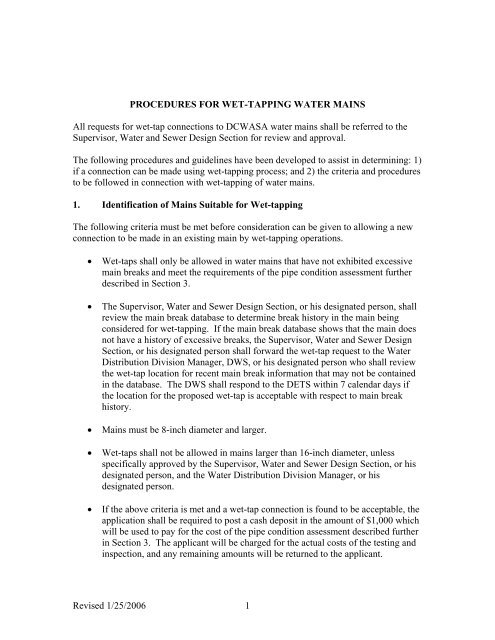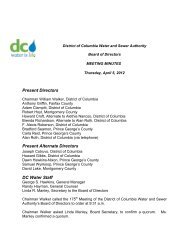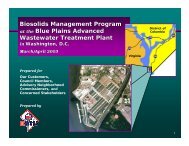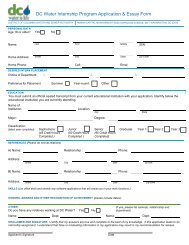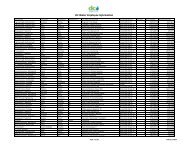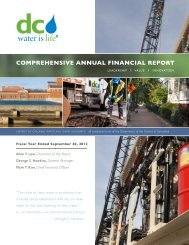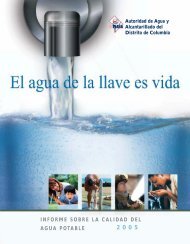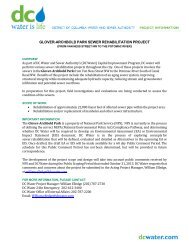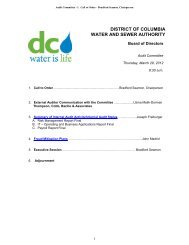procedures for wet-tapping water mains - DC Water
procedures for wet-tapping water mains - DC Water
procedures for wet-tapping water mains - DC Water
Create successful ePaper yourself
Turn your PDF publications into a flip-book with our unique Google optimized e-Paper software.
PROCEDURES FOR WET-TAPPING WATER MAINSAll requests <strong>for</strong> <strong>wet</strong>-tap connections to <strong>DC</strong>WASA <strong>water</strong> <strong>mains</strong> shall be referred to theSupervisor, <strong>Water</strong> and Sewer Design Section <strong>for</strong> review and approval.The following <strong>procedures</strong> and guidelines have been developed to assist in determining: 1)if a connection can be made using <strong>wet</strong>-<strong>tapping</strong> process; and 2) the criteria and <strong>procedures</strong>to be followed in connection with <strong>wet</strong>-<strong>tapping</strong> of <strong>water</strong> <strong>mains</strong>.1. Identification of Mains Suitable <strong>for</strong> Wet-<strong>tapping</strong>The following criteria must be met be<strong>for</strong>e consideration can be given to allowing a newconnection to be made in an existing main by <strong>wet</strong>-<strong>tapping</strong> operations.• Wet-taps shall only be allowed in <strong>water</strong> <strong>mains</strong> that have not exhibited excessivemain breaks and meet the requirements of the pipe condition assessment furtherdescribed in Section 3.• The Supervisor, <strong>Water</strong> and Sewer Design Section, or his designated person, shallreview the main break database to determine break history in the main beingconsidered <strong>for</strong> <strong>wet</strong>-<strong>tapping</strong>. If the main break database shows that the main doesnot have a history of excessive breaks, the Supervisor, <strong>Water</strong> and Sewer DesignSection, or his designated person shall <strong>for</strong>ward the <strong>wet</strong>-tap request to the <strong>Water</strong>Distribution Division Manager, DWS, or his designated person who shall reviewthe <strong>wet</strong>-tap location <strong>for</strong> recent main break in<strong>for</strong>mation that may not be containedin the database. The DWS shall respond to the DETS within 7 calendar days ifthe location <strong>for</strong> the proposed <strong>wet</strong>-tap is acceptable with respect to main breakhistory.• Mains must be 8-inch diameter and larger.• Wet-taps shall not be allowed in <strong>mains</strong> larger than 16-inch diameter, unlessspecifically approved by the Supervisor, <strong>Water</strong> and Sewer Design Section, or hisdesignated person, and the <strong>Water</strong> Distribution Division Manager, or hisdesignated person.• If the above criteria is met and a <strong>wet</strong>-tap connection is found to be acceptable, theapplication shall be required to post a cash deposit in the amount of $1,000 whichwill be used to pay <strong>for</strong> the cost of the pipe condition assessment described furtherin Section 3. The applicant will be charged <strong>for</strong> the actual costs of the testing andinspection, and any remaining amounts will be returned to the applicant.Revised 1/25/2006 1
2. Wet-<strong>tapping</strong> CriteriaWet-taps shall be made in accordance with the following criteria:• The tapped connection shall be at least one size smaller than the pipe beingtapped, i.e. 12-inch diameter pipe being tapped, the maximum <strong>tapping</strong> diameterwould be 10-inch diameter.• Wet-taps shall be at least 6-inch diameter and larger, no 4-inch diameter taps or<strong>tapping</strong> valves are permitted. Two (2”) inch taps will be allowed with a preapproved<strong>tapping</strong> assembly.• Tapping sleeves shall be installed at least 4-feet from any exposed pipe joint orexisting tap.• Tapping sleeves shall be full-body ductile iron. Valves shall be as approved by<strong>DC</strong>WASA. Contractor shall submit shop drawings of the proposed sleeve andvalve to the Supervisor, Civil and Structural Section <strong>for</strong> approval prior toundertaking any work.• Wet-taps shall be made only by experienced contractors specializing in theinstallation of <strong>wet</strong>-taps. (Refer to Contractor experience and qualifications,Section 5 <strong>for</strong> requirements relative to this item.)• Wet-tap installation and testing shall be made in accordance with themanufacturer’s recommendations. The <strong>tapping</strong> saddle shall be designed <strong>for</strong> thetest pressure of the main being tapped.• Prior to undertaking any work, or ordering of materials, the Contractor shall testpit the pipe at the location of the tap and verify the outside diameter of the pipe toinsure that the correct size saddle is provided.• Contractor shall be responsible <strong>for</strong> obtaining a Public Space Permit from DDOTand complying with all requirements of this permit, including placement andmaintenance of temporary steel plating.• Contractor shall provide all required sheeting, shoring, bracing, de<strong>water</strong>ing, etc.to maintain a safe and dry excavation throughout the <strong>wet</strong>-tap installation process.3. Pipe Condition AssessmentRevised 1/25/2006 2
• In order to determine if the pipe is suitable <strong>for</strong> <strong>tapping</strong>, the <strong>DC</strong>WASA Inspectorwill arrange to have the pipe tested by <strong>DC</strong>WASA’s Corrosion Consultant.• The pipe condition assessment shall be undertaken at the same time as theContractor is undertaking the test pit operations to confirm the outside diameter ofthe pipe. To avoid delays, the Contractor shall provide <strong>DC</strong>WASA with at least 7calendar days advance notice when the test pitting operations will be undertakenso that the <strong>DC</strong>WASA Inspector can coordinate the pipe condition assessmenttesting.• The Contractor shall allow <strong>DC</strong>WASA’s Corrosion Consultant 4 hours to inspectand test the pipe. The Contractor shall completely expose and cleanapproximately 4 feet of pipe so that <strong>DC</strong>WASA’s Corrosion Consultant can obtainfull access to the pipe to conduct the inspection and testing of the pipe.• Following completion of the testing, the Corrosion Consultant will advise the<strong>DC</strong>WASA Inspector of the suitability of the pipe to receive the <strong>wet</strong>-tap. If thepipe is deemed in suitable condition <strong>for</strong> <strong>wet</strong>-<strong>tapping</strong>, the Contractor will beauthorized to proceed with the <strong>wet</strong>-<strong>tapping</strong> operation. The Contractor shallcoordinate the time and date of the work with the <strong>DC</strong>WASA Inspector.• If the main is found to be unsuitable <strong>for</strong> <strong>wet</strong>-<strong>tapping</strong>, the Contractor will beadvised that the connection to the main shall be made by dry cut operations andnot by <strong>wet</strong>-<strong>tapping</strong>. Under these conditions the Contractor shall coordinate theshutdown of the main with the <strong>DC</strong>WASA Inspector. This shutdown may requirerescheduling the work depending on the availability of DWS crews to shutdownthe main.4. WASA Inspection• No work associated with the <strong>wet</strong>-<strong>tapping</strong> of <strong>water</strong> <strong>mains</strong> shall be undertakenwithout a <strong>DC</strong>WASA Inspector present. The Contractor shall provide the<strong>DC</strong>WASA Inspector at least three (3) days notice to schedule when <strong>wet</strong>-<strong>tapping</strong>operations are to take place.• Following completion of the <strong>wet</strong>-tap, the Contractor shall provide the pipe couponto the <strong>DC</strong>WASA Inspector. The pipe coupon will be tagged by the inspector anddelivered to <strong>DC</strong>WASA’s Corrosion Consultant <strong>for</strong> further testing and evaluation.5. Contractor Experience and Qualifications• Wet-<strong>tapping</strong> of <strong>water</strong> <strong>mains</strong> shall only be made by individuals experienced andqualified in <strong>wet</strong>-<strong>tapping</strong> operations and <strong>procedures</strong>.Revised 1/25/2006 3
• Any Contractor interested in per<strong>for</strong>ming <strong>wet</strong>-<strong>tapping</strong> operations on <strong>DC</strong>WASA<strong>water</strong> <strong>mains</strong> shall be approved prior to undertaking any <strong>wet</strong>-<strong>tapping</strong> operations.The Contractor shall submit his experience and qualifications to the Supervisor,<strong>Water</strong> and Sewer Design Section <strong>for</strong> review and approval. As a minimum, theindividuals per<strong>for</strong>ming the work shall have at least five (5) years experience in the<strong>wet</strong>-<strong>tapping</strong> of <strong>water</strong> <strong>mains</strong> in the sizes being considered. Contractor shallsubmitted proof of experience and qualifications including, but not limited to,listing of similar projects completed over the past three (3) years including clientreference; listing of equipment; and resumes of personnel to be used on theproject. Contractors who are approved <strong>for</strong> <strong>wet</strong>-<strong>tapping</strong> operations by anotherlocal jurisdiction may submit the appropriate approval certification <strong>for</strong> approval.The Contractor shall per<strong>for</strong>m the tap-work under the supervision of a certifiedDistrict of Columbia Master Plumber. The work shall be inspected <strong>for</strong> approvalby the District of Columbia after <strong>DC</strong>WASA approves the work.• In addition to the submission of experience and qualifications of the field crews,the Contractor shall submit his proposed sequence of operations <strong>for</strong> <strong>tapping</strong> the<strong>mains</strong>, discussing in place quality control and test <strong>procedures</strong> to be used to insurethat the <strong>wet</strong>-tap is successfully made.6. Maintenance Bond• The Contractor shall guarantee that the <strong>wet</strong>-tap connection shall be leak-free <strong>for</strong> aperiod of two (2) years.• The Contractor shall post with <strong>DC</strong>WASA, an annual Maintenance Bond in theamount of $15,000. The bond shall require that the Contractor address anyrepairs associated with leaking sleeves or valves that are found to be the result ofpoor workmanship or materials. If any portion of the Bond is used to addressrepair or replacement issues, the Contractor shall restore the full amount of theBond be<strong>for</strong>e being permitted to undertake additional <strong>wet</strong>-taps in the system.Revised 1/25/2006 4


